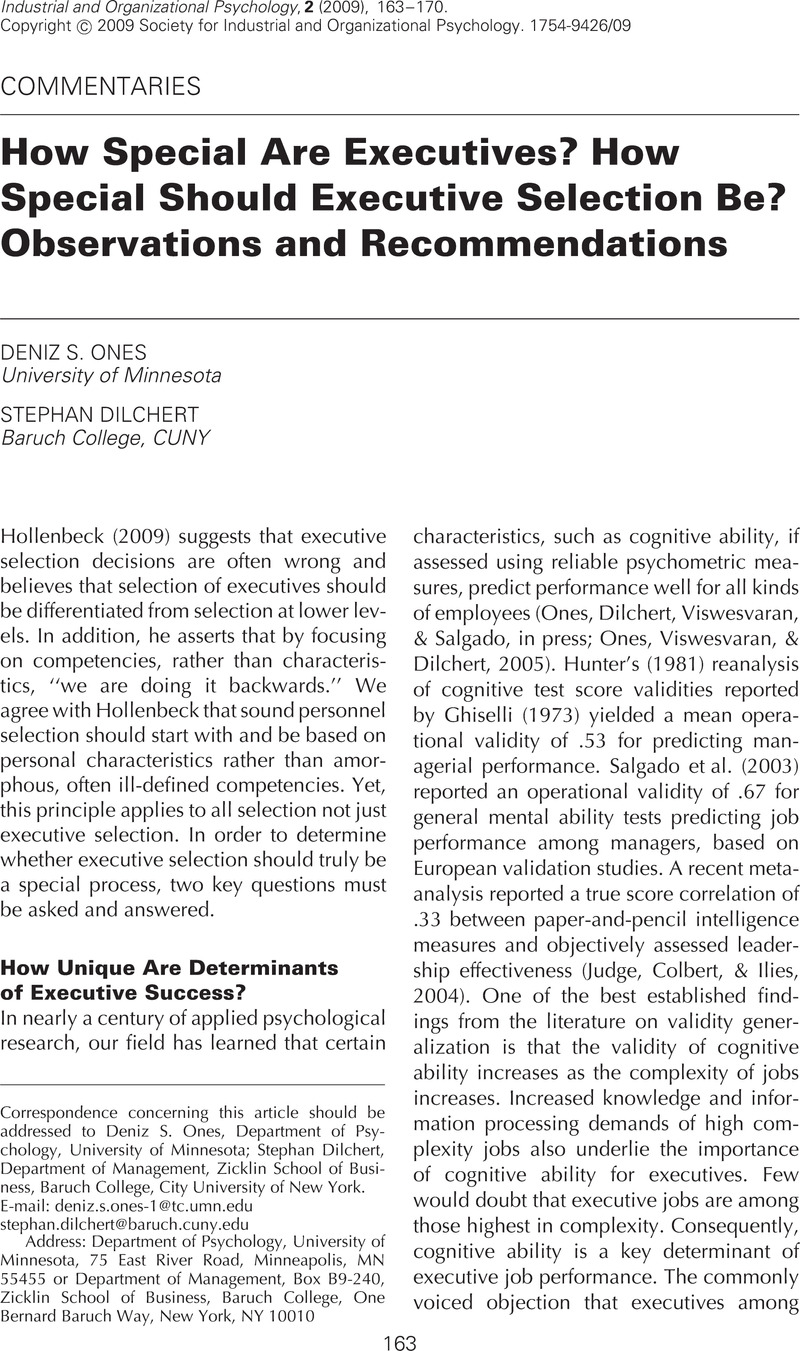Crossref Citations
This article has been cited by the following publications. This list is generated based on data provided by Crossref.
Silzer, Rob
and
Church, Allan H.
2009.
The Pearls and Perils of Identifying Potential.
Industrial and Organizational Psychology,
Vol. 2,
Issue. 4,
p.
377.
Hollenbeck, George P.
2009.
Executive Selection — Response to Commentaries.
Industrial and Organizational Psychology,
Vol. 2,
Issue. 2,
p.
177.
Viswesvaran, Chockalingam
and
Ones, Deniz S.
2010.
International Review of Industrial and Organizational Psychology 2010 Volume 25.
p.
169.
Kuncel, Nathan R.
Ones, Deniz S.
and
Sackett, Paul R.
2010.
Individual differences as predictors of work, educational, and broad life outcomes.
Personality and Individual Differences,
Vol. 49,
Issue. 4,
p.
331.
Lievens, Filip
Klehe, Ute-Christine
and
Libbrecht, Nele
2011.
Applicant Versus Employee Scores on Self-Report Emotional Intelligence Measures.
Journal of Personnel Psychology,
Vol. 10,
Issue. 2,
p.
89.
Klehe, Ute-Christine
2011.
Scientific Principles Versus Practical Realities: Insights From Organizational Theory to Individual Psychological Assessment.
Industrial and Organizational Psychology,
Vol. 4,
Issue. 3,
p.
311.
Lodato, Michael A.
Highhouse, Scott
and
Brooks, Margaret E.
2011.
Predicting professional preferences for intuition‐based hiring.
Journal of Managerial Psychology,
Vol. 26,
Issue. 5,
p.
352.
Sosik, John J.
Juzbasich, John
and
Chun, Jae Uk
2011.
Effects of moral reasoning and management level on ratings of charismatic leadership, in-role and extra-role performance of managers: A multi-source examination.
The Leadership Quarterly,
Vol. 22,
Issue. 2,
p.
434.
Silzer, Rob
and
Jeanneret, Richard
2011.
Individual Psychological Assessment: A Practice and Science in Search of Common Ground.
Industrial and Organizational Psychology,
Vol. 4,
Issue. 3,
p.
270.
Grant, Adam M.
Gino, Francesca
and
Hofmann, David A.
2011.
Reversing the Extraverted Leadership Advantage: The Role of Employee Proactivity.
Academy of Management Journal,
Vol. 54,
Issue. 3,
p.
528.
Boudrias, Jean-Sébastien
and
Morin, Denis
2011.
Démystifier les inventaires de personnalité.
Gestion,
Vol. Vol. 36,
Issue. 3,
p.
61.
HINRICHS, KIM T.
WANG, LEI
HINRICHS, ANDREW T.
and
ROMERO, ERIC J.
2012.
Moral Disengagement Through Displacement of Responsibility: The Role of Leadership Beliefs.
Journal of Applied Social Psychology,
Vol. 42,
Issue. 1,
p.
62.
Grant, Adam M.
2013.
Rethinking the Extraverted Sales Ideal.
Psychological Science,
Vol. 24,
Issue. 6,
p.
1024.
Vinkenburg, Claartje J.
Jansen, Paul G. W.
Dries, Nicky
and
Pepermans, Roland
2014.
Arena.
Group & Organization Management,
Vol. 39,
Issue. 1,
p.
33.
Kanning, Uwe Peter
2014.
Spiel zur Beobachtung von Kooperation, Analytik und Strategie im Assessment Center (SPIKAS-AC).
Zeitschrift für Arbeits- und Organisationspsychologie A&O,
Vol. 58,
Issue. 4,
p.
215.
Kanning, Uwe Peter
2015.
Handbuch Mitarbeiterführung: Wirtschaftspsychologisches Praxiswissen für Fach- und Führungskräfte.
p.
1.
Kanning, Uwe Peter
2015.
Personalauswahl in der Wissenschaft.
p.
83.
Booth, Tom
Murray, Aja Louise
Overduin, Mathilde
Matthews, Madelynn
and
Furnham, Adrian
2016.
Distinguishing CEOs from Top Level Management: A Profile Analysis of Individual Differences, Career Paths and Demographics.
Journal of Business and Psychology,
Vol. 31,
Issue. 2,
p.
205.
Kanning, Uwe Peter
2016.
Handbuch Mitarbeiterführung.
p.
97.
Lounsbury, John W.
Sundstrom, Eric D.
Gibson, Lucy W.
Loveland, James M.
and
Drost, Adam W.
2016.
Core personality traits of managers.
Journal of Managerial Psychology,
Vol. 31,
Issue. 2,
p.
434.





